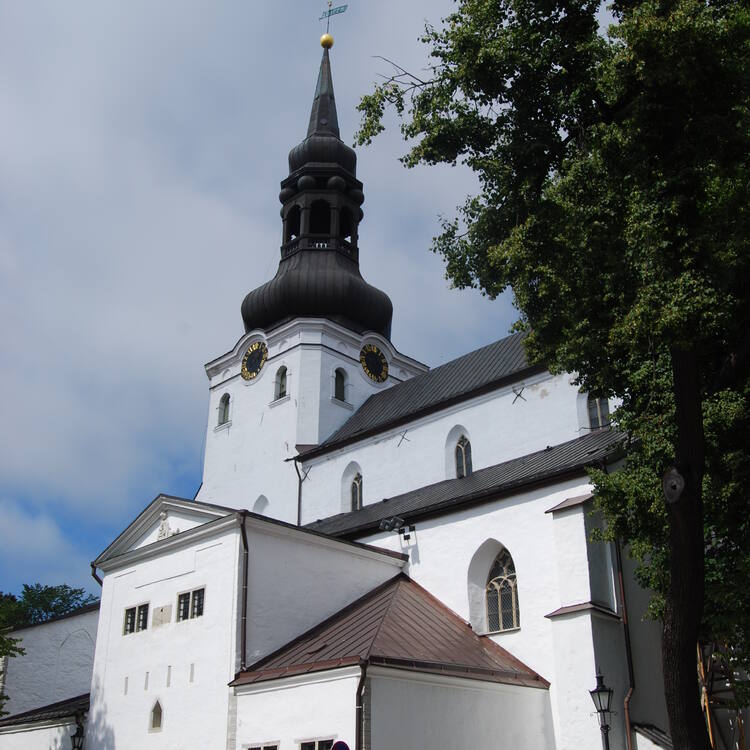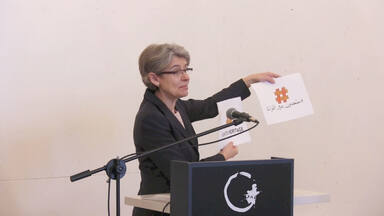Historic Centre (Old Town) of Tallinn
Historic Centre (Old Town) of Tallinn
The origins of Tallinn date back to the 13th century, when a castle was built there by the crusading knights of the Teutonic Order. It developed as a major centre of the Hanseatic League, and its wealth is demonstrated by the opulence of the public buildings (the churches in particular) and the domestic architecture of the merchants' houses, which have survived to a remarkable degree despite the ravages of fire and war in the intervening centuries.
Description is available under license CC-BY-SA IGO 3.0
Centre historique (vieille ville) de Tallinn
Les origines de Tallinn remontent au XIIIe siècle, lorsqu'un château fut édifié par les croisés de l'ordre Teutonique. La cité s'est développée pour devenir un poste clé de la Ligue hanséatique et sa prospérité s'est traduite par l'opulence des édifices publics (en particulier ses églises) et l'architecture domestique des maisons de marchands, remarquablement bien préservées malgré les ravages des incendies et des guerres au cours des siècles.
Description is available under license CC-BY-SA IGO 3.0
وسط مدينة تالين التاريخي (المدينة القديمة)
ترقى مدينة تالين إلى القرن الثالث عشر عندما شيّدت فرقة من الصليبيين قلعة حصينة هناك. ونمت المدينة وتطوّرت لتصبح شعلة العصبة التحالفيّة وترجم ازدهارها من خلال غنى المباني العامة (خصوصاً الكنائس) والهندسة المحليّة لمنازل التجّار والتي جرت المحافظة عليها أبلغ محافظة على الرغم من الحرائق والحروب التي اندلعت على مرّ القرون.
source: UNESCO/CPE
Description is available under license CC-BY-SA IGO 3.0
塔林历史中心(老城)
塔林的起源可追溯到13世纪,当时的条顿骑士团的十字军骑士们在这里建造了一个城堡, 后来,这里又发展成为汉斯同盟(Hanseatic League)的主要中心。在后来的几个世纪,这里屡遭战火,但许多建筑还是较为完好地保留了下来,公共建筑(特别是教堂)之豪华以及商店内部装璜之考究充分展示了当时这里的繁荣和富裕。
source: UNESCO/CPE
Description is available under license CC-BY-SA IGO 3.0
Исторический центр (Старый город) Таллинна
Старое эстонское укрепление на холме Тоомпеа, вокруг которого позже возник город Таллинн, было захвачено в XIII в. датчанами, но в дальнейшем оно перешло к Ливонскому Ордену. Город развивался как важный центр Ганзейского союза, и его благосостояние подтверждается богатством общественных зданий, особенно церквей, и жилой архитектурой купеческих домов, несмотря на пожары и войны минувших столетий сохранившиеся в весьма хорошем состоянии.
source: UNESCO/CPE
Description is available under license CC-BY-SA IGO 3.0
Centro histórico (ciudad vieja) de Tallin
Los orígenes de Tallin se remontan al siglo XIII, con la edificación de un castillo por los caballeros cruzados de la Orden Teutónica. Luego, la ciudad se fue desarrollando hasta convertirse en uno de los principales centros de la Liga Hanseática. Su prosperidad de esa época se patentizó en la opulencia de sus edificios públicos –en particular las iglesias– y la arquitectura de las mansiones de los mercaderes, muy bien conservadas a pesar de los estragos causados por los incendios y las guerras a lo largo de los siglos.
source: UNESCO/CPE
Description is available under license CC-BY-SA IGO 3.0
タリン歴史地区(旧市街)
source: NFUAJ
Historisch centrum (oude stad) van Tallinn
Source: unesco.nl
Outstanding Universal Value
Brief synthesis
The Historic Centre (Old Town) of Tallinn is an exceptionally complete and well-preserved medieval northern European trading city on the coast of the Baltic Sea. The city developed as a significant centre of the Hanseatic League during the major period of activity of this great trading organization in the 13th-16th centuries.
The combination of the upper town on the high limestone hill and the lower town at its foot with many church spires forms an expressive skyline that is visible from a great distance both from land and sea.
The upper town (Toompea) with the castle and the cathedral has always been the administrative centre of the country, whereas the lower town preserves to a remarkable extent the medieval urban fabric of narrow winding streets, many of which retain their medieval names, and fine public and burgher buildings, including town wall, Town Hall, pharmacy, churches, monasteries, merchants’ and craftsmen’ guilds, and the domestic architecture of the merchants' houses, which have survived to a remarkable degree. The distribution of building plots survives virtually intact from the 13th-14th centuries.
The Outstanding Universal Value of the Historic Centre (Old Town) of Tallinn is demonstrated in its existence as an outstanding, exceptionally complete and well preserved example of a medieval northern European trading city that retains the salient features of this unique form of economic and social community to a remarkable degree.
Criterion (ii): The Historic Centre of Tallinn, among the most remote and powerful outposts of the colonizing activities of the Hanseatic League in the north-eastern part of Europe in the 13th-16th centuries, provided a crucible within which an international secular-ecclesiastical culture resulting from the interchange of Cistercians, Dominicans, the Teutonic Order and the traditions of the Hanseatic League, formed and was itself exported throughout northern Europe.
Criterion (iv): The town plan and the buildings within it constitute a remarkable reflection of the coexistence of the seat of feudal overlords and a Hanseatic trading centre within the shelter of a common system of walls and fortifications.
Integrity
The boundaries of the inscribed World Heritage property and its buffer zone were modified in 2008 in order to bring the boundaries of the inscribed property in conformity with the boundaries of the Tallinn Old Town Conservation Area, recognized as a national monument in Estonia. The historic centre of Tallinn World Heritage property (thus increased from 60 ha. to 113 ha.) now encompasses the upper town (Toompea), the lower town inside the medieval walls, as well as the 17th century historic fortifications surrounding the entire Old Town, and a range of primarily 19th century structures, streetscapes and views, which today form a green area around the medieval city. This modification has ensured inclusion of all primary elements contributing to the outstanding universal value of the property, and strongly enhanced its completeness and integrity.
The buffer zone, increased from 370 ha to 2253 ha, also in 2008, now protects the immediate setting of the inscribed property in a much more complete fashion. Extended to the sea to include views from Viimsi and Kopli peninsulas, the buffer zone now includes 9 view sectors and 5 view corridors.
To date, Tallinn has maintained its characteristic skyline visible from both the sea and the land. The characteristic skyline however could be vulnerable because of planned high rise development outside the buffer zone.
Authenticity
The site preserves to a remarkable extent the medieval urban structure of building plots, streets and squares, set out in the 13th century, as well as medieval urban fabric. The radial street network is well endowed with buildings from the 14th-16th centuries. The town defences have been preserved over large sections at their original length and height, rising to over 15m in places.
In addition to architectural continuity, Old Town has retained its traditional use as a living city, hosting domestic, commercial and religious functions, and retaining the upper town as the administrative centre of the country. Nevertheless increasingly historic residential buildings are being refurbished for touristic or public use and thus subject to increased life safety and accessibility requirements.
The authentic setting of the inscribed World Heritage property includes some significant architecture from the late 19th century and early 20th century including theatres and schools as well as a number of exceptional wooden suburbs which form an integral part of the historic, urban fabric round Tallinn Old Town.
Until recently the survival of the wooden quarters was threatened by unclear ownership in the years following independence and in a general indifference to the qualities they offered residents. This latter could be seen in a lack of maintenance, and inappropriate upgrading and repair approaches. Today however the situation is turned around and these wooden areas are much valued, and adequate measures are in place to maintain their authenticity.
Protection and management requirements
The Tallinn Old Town conservation area established in 1966 by regulation Nr 360 of the Council of Ministers of the Estonian Socialist Soviet Republic (ESSR), and confirmed in 1996 by the Ministry of Culture of the Republic of Estonia, was the first conservation area established in the former USSR. It was intended to sustain the well-preserved physical substance and integrity of the entire property.
Several contemporary legislative and local government documents also complement the protection of the values of Tallinn Old Town and regulate its administration. These include the Statutes of the Heritage Conservation Area of Tallinn Old Town (Historic Centre) based upon the Heritage Conservation Act of 2002 (amended in 2011). These Statutes, fully applicable to the inscribed property following increase of the boundaries of the property in 2008 and its buffer zone, are focused on managing preservation, conservation, planning and building activities within the area and related supporting administrative arrangements. More specifically, the Statutes provide for maintaining the historic plot structure, building volume and density, historic structures and details of the World Heritage property.
The revised Heritage Conservation Act ensures that research and design permits and activity licensing provisions apply to all structures within the World Heritage property, not just listed monuments. These ensure that all necessary historical and archaeological research is conducted before any building activity is carried out in the inscribed property.
Responsibility for implementation of these regulations and statutes is shared between the National Heritage Board and the Tallinn City Government. Overall supervision is conducted by the National Heritage Board (state level), while the Tallinn Cultural Heritage Department (municipal level) is in charge of direct implementation of the statutes. Experts of the Heritage Conservation Advisory Panel provide consultation on specific questions and issues. Decisions concerning planning and building within the World Heritage property are made by consensus of the National Heritage Board and Tallinn City Government.
The Tallinn Old Town Management Committee has been established in 2010 to strengthen cooperation and co-ordination among responsible organizations, NGOs, local community and other stakeholders.It is also responsible for approving, enhancing and monitoring implementation of the comprehensive management plan of the property (scheduled to be finalized by December 2011). The latter plan will replace the “Development Plan of Tallinn Old Town” 2008-2013, enacted on 28 August 2008, and give prominence to protecting the Outstanding Universal Value of the property.
Existing management provisions are aided by municipal initiatives (appointment of a full time archaeologist the Cultural Heritage Department in 2010, to increase provisions for archaeological monitoring where new work is envisioned) and guidance obtained from important public forums (e.g., the May 2002 conference “Alternatives to Historical Reconstruction in UNESCO World Heritage Cities” whose concluding resolution provides a number of key principles guiding future development within the inscribed property).
Future management strategies should support efforts to strengthen provisions for sustaining authenticity and integrity. Management strategies must attempt to balance residential use with other private/public uses which may threaten the authenticity of the affected structures.The threat to integrity from high rise development outside of the buffer zone is partly addressed in the thematic plan “Framework for high-rise buildings in Tallinn” (adopted by Tallinn City Council in 2008), which contributes to the protection of the skyline, and associated view sectors and view corridors. However effective use of the Thematic Plan to fully preserve the visual integrity of the World Heritage property requires efforts to strengthen consensus among all concerned stakeholders about effective means for in situ implementation of the Plan in all identified view sectors.




